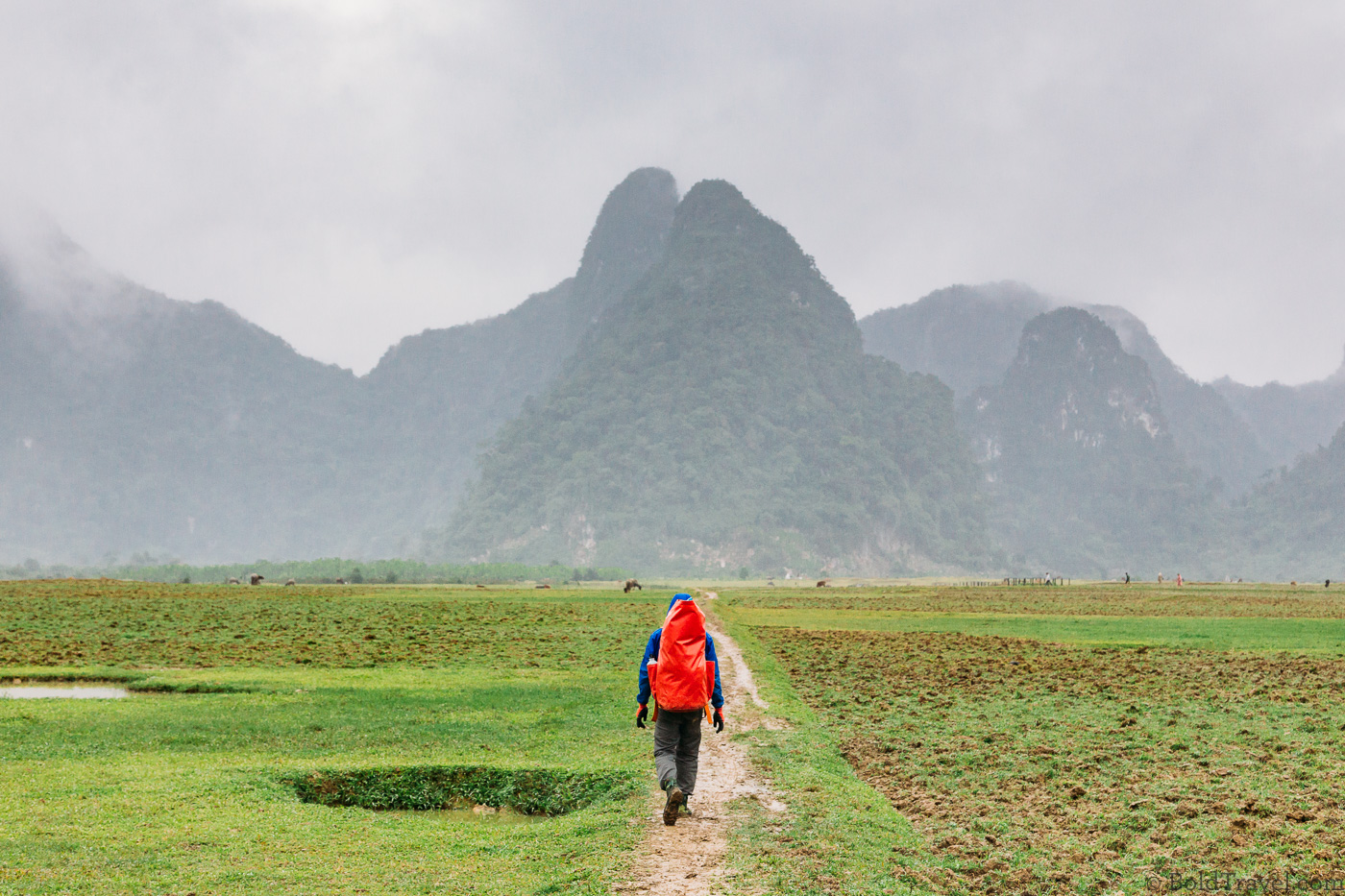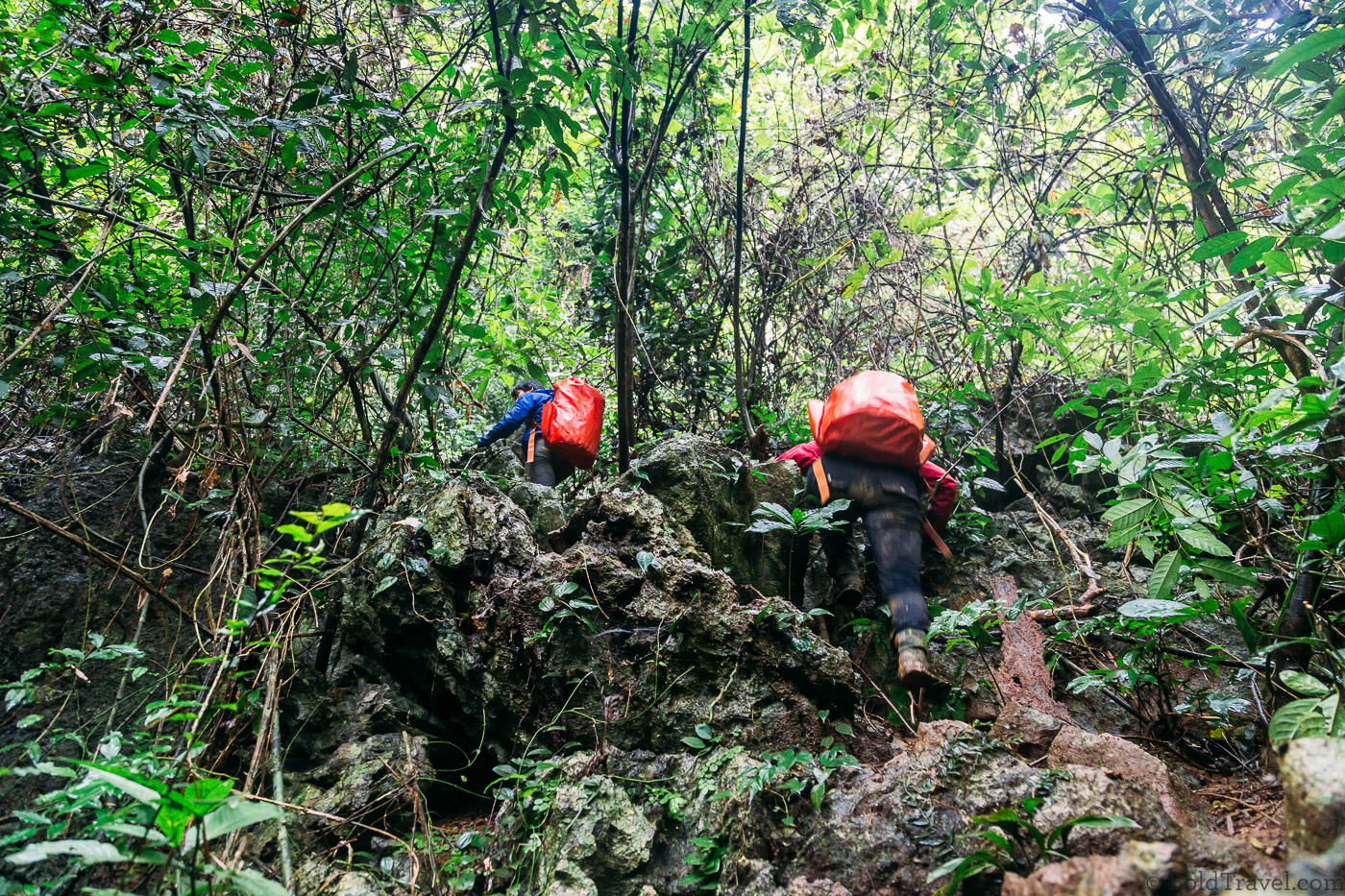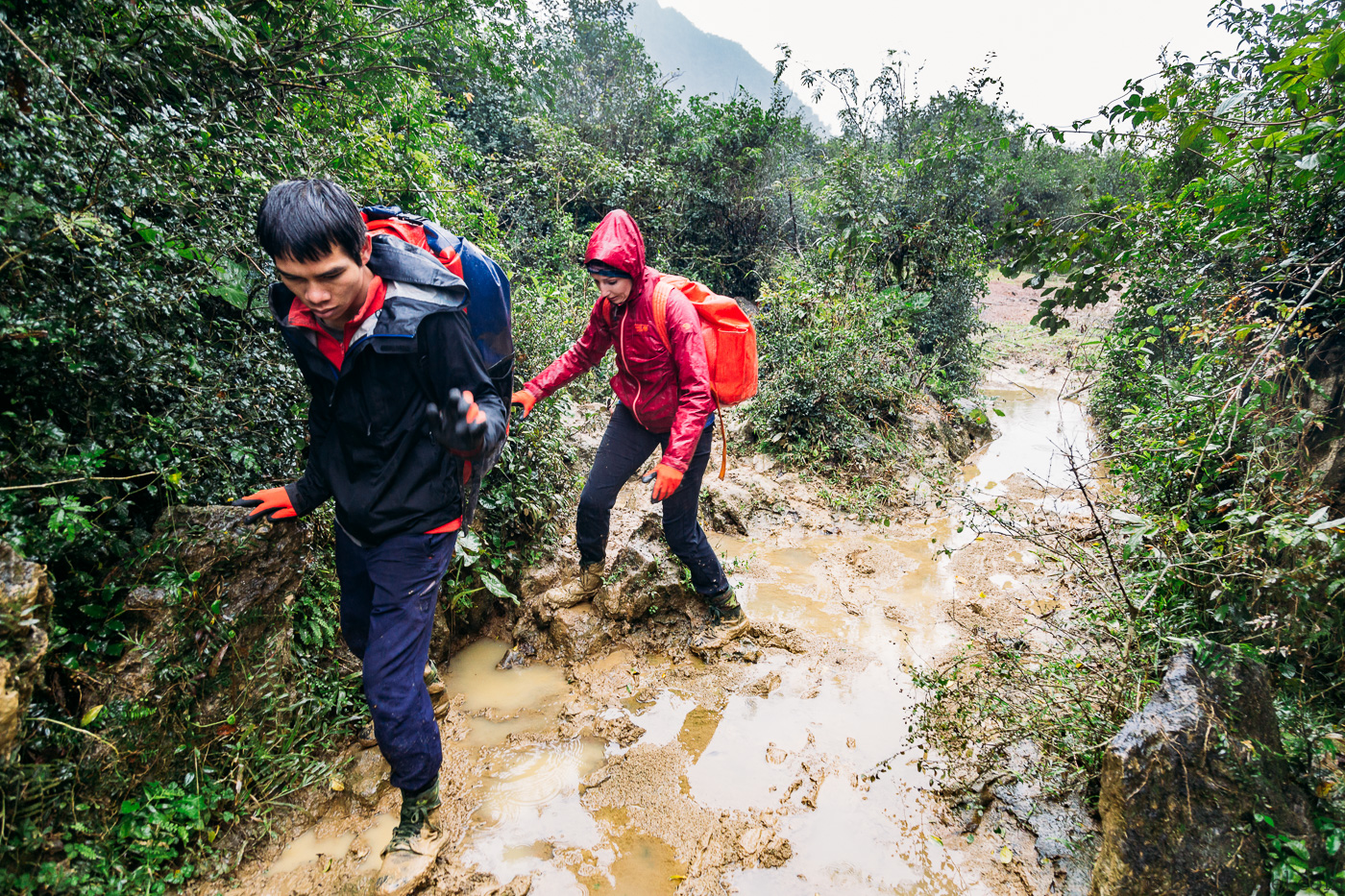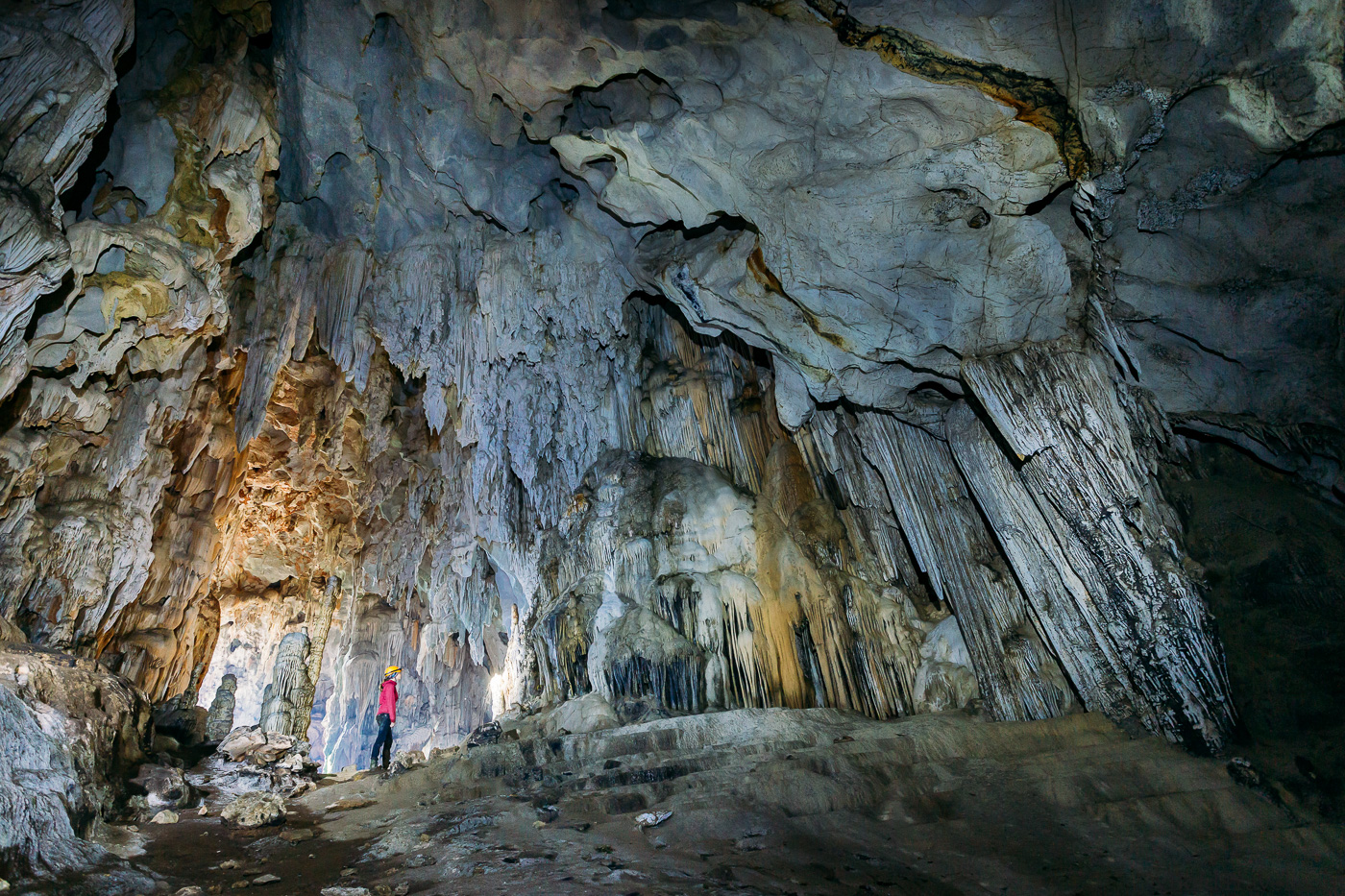Seven picked up a smooth cave pearl measuring the size of a golf ball and handed it to Adam. It was hard to fathom that this perfectly round ball of calcite had formed over hundreds, if not thousands, of years from individual drips of water each building new calcite layers around a single grain of sand. We would learn that this one was not unlike the treasure chest of pearls found inside neighboring Hang Son Doong, recently named the world’s largest cave. And cave pearls were just one of the natural marvels of the Phong Nha caves we got to explore in the La Ken valley during our 2-day Tu Lan Jungle Challenge with Oxalis. We had just spent the better part of an hour searching for cave ribbons and soda straws while dodging stalactites and scrambling through small passageways into pitch black caverns. Although our tour in the Phong Nha region focused more on jungle trekking than caving, our adventures inside the caves were a welcome respite from the unexpected pouring rain and undoubtedly the coolest part of our Phong Nha experience.
 About The Caves of Phong Nha, Vietnam
About The Caves of Phong Nha, Vietnam
The landscapes of Phong Nha Ke Bang National Park and neighboring La Ken Valley in Quang Binh Province of Central Vietnam are the stuff Hollywood movies are made of. (In fact, we got to watch Samual L. Jackson filming Kong: Skull Island during our trek!) Imposing limestone karsts dating back 400 million years lush with densely thicketed tropical jungle and dotted with remote agrarian villages and roaming water buffalo. It is picture perfect.
But even more spectacular is what is hiding below – a network of hundreds of caves extraordinary in size and geology featuring underground rivers, caverns the length of two football fields and whole living ecosystems. Phong Nha-Ke Bang National Park was declared a UNESCO World Heritage site back in 2003 due to its endowment of underworld treasures but regular cave expeditions are still uncovering new caves and cave systems in the area.
 Caving Options In & Around Phong Nha
Caving Options In & Around Phong Nha
According to our guide Seven over 300 caves to date have been explored by speleologists in the Phong Nha region and it is suspected that this represents only 25% of all of the caves in the area.
Most notorious is Hang Son Doong, now confirmed as the world’s largest cave since 2009. 5-day caving expeditions of Hang Son Doong are run exclusively through Oxalis at the hefty price tag of $3,000 per person. If the price tag doesn’t scare you away, get your name on the list early as this tour books out years in advance.
Also in Phong Nha is Hang En, the world’s third largest cave. Hang En is unique in that it is a shorter 2-day caving expedition offering the opportunity to camp overnight inside the opening of its massive cavern. This is a great option if you are looking for a unique overnight caving experience without too strenuous of trekking and spelunking.
Hang Va is one of the newest caving expeditions to open up in the area and the one we were hoping to explore. The price tag is steep but far more reasonable than Hang Son Doong. In retrospect, we probably should have saved our money for this tour since our favorite part of the Phong Nha experience was exploring the caves and Hang Va has some pretty extraordinary features to photograph.
Discovered in 2009, the Tu Lan cave system is comprised of 8 documented caves sitting approximated 70 kilometers outside of the town of Phong Nha. The most famous is the Tu Lan cave however there are opportunities for 1, 2, 3 and 4-day caving adventures. We opted to explore some of the lesser-known caves of the Tu Lan cave system, including Bat Cave, Gibbon Cave and Rat Cave, while on the Tu Lan Jungle Challenge tour with Oxalis. We choose this tour because we were looking for a bit more of an adventurous and physically challenging expedition in 2 days or less (which is all our budget would allow). What we didn’t realize was that we actually would have preferred to spend more of our time caving and spelunking instead of trekking, so in the end this tour probably wasn’t the best suited for our interests. That said, we still got to spend a good deal of time seeing some of the lesser visited caves in the region.
If you aren’t up for a longer (and generally more expensive) caving excursion, look to day trips to the local Phong Nha caves like the Dark Cave (Hang Toi) where you can splash around in mud, Phong Nha Cave and the beautifully lit caverns of Paradise Cave.
 Oxalis’ Tu Lan Jungle Challenge
Oxalis’ Tu Lan Jungle Challenge
Our trek started early with a pick-up from our Phong Nha hostel at 7:30am. As we were the only ones on the tour this day, we headed straight out of town to the Tan Hoa headquarters approximately 70 kilometers away. Unluckily for us, the rain hadn’t stopped in days (somewhat unusual weather for the end of February) and it was only getting worse the further we drove from Phong Nha’s largest town so we knew we were in for a wet two days of trekking.
We reached the Oxalis satellite office around 9:00am where our guide Dzung(“Seven”) oriented us on the schedule for the next two days and introduced us to our porter Ding. We would also be meeting up with our two cooks, Mr. Dong and Chinh, later that evening at the campsite.
We were asked to place all of our overnight items in plastic bags, which Ding would carry for us in his bag, while we were responsible for carrying all of the items we would need for the day on our own. Since it was pouring rain, Oxalis provided us with water-resistent bags in which to place our stuff. We were also supplied with helmets and gloves which we would need anytime we entered the caves and as it turns out to protect us from the thorny bushes lining the trail.
Oxalis also offered us caving boots to trek in which were essentially high top Chuck Taylors with more grip. Adam opted to wear his own sneakers while I went with the Chuck Taylors. While I ended the trek with some big blisters on my feet thanks to the constant rub with my soaked socks, I was happy to have been wearing their boots as they had far more grip than the shoes I had with me and there were some pretty steep up and downhill traverses.
Once we were packed and ready we set off from the office down a small path used mostly by local farmers. Initially the trek was tame and mild, taking us through green agricultural land surrounded by towering mist-covered limestone peaks. It reminded us of the eerily beautiful gray days aboard the Treasure Junk on Halong Bay.
Soon enough we were navigating our way through a tangled mess of thorny jungle thicket. Where I imagine a dirt trail used to be now was a soupy mud mess. Needless to say it was a slow and sloppy couple of hours.
After walking in the rain for the better part of the morning we stopped for a lunch. Dzung and Ding made a shelter for us to eat under which provided us temporary refuge from the elements.
By early afternoon, it was decided that we wouldn’t be going the traditional trekking route to the water cave seeing as we had already spent the day soaked. So instead Dzung led us to a cave about an hour away so newly discovered it didn’t have an official name yet. It was a steep and somewhat uncharted hike up to the entrance of the cave but well worth it once we were inside. It was the happiest part of the day getting to navigate large caverns and small passageways in search of bones, cave pearls and creepy crawly critters.
By the time we emerged from the darkness of the cave, it was nearing dusk. It took us another 40-minutes to trek to our campsite where Mr. Dong and Chinh were awaiting us with a hot fire and deliciously cooked meal. The Oxalis crew was amazing, despite the crappy weather, and kept our spirits uplifted with jokes and drinking games. With a long and cold day behind us it wasn’t long before we retired to our tent to sleep.
The next morning we awoke early and pulled back on our still rather damp clothes. Luckily the rain was dissipating at this point so we had to worry less about trekking soaked. Today, Dzung would take us to three more caves in the Tu Lan cave system including Bat Cave, Rat Cave and Gibbon Cave. Each of the three caves was stunning in its own right but I think Gibbon Cave for me was the clear winner.
While Oxalis’ Tu Lan Jungle Challenge is more of a trekking adventure than a caving one, we definitely most appreciated the time we spent inside the Tu Lan cave systems rather than out in the jungle which probably was a good indication that we choose the wrong tour option!
By the end of our second day, we were happily trekked out and ready to return to the Tan Hoa headquarters to be transported back to Phong Nha’s main town Son Trach.
 Know Before You Go: Tu Lan Jungle Challenge
Know Before You Go: Tu Lan Jungle Challenge
The Tu Lan Jungle Challenge (also shown as La Ken Jungle Challenge on the Oxalis website) is first and foremost a trekking adventure rather than a caving adventure. This is an important distinction which I don’t think we completely understood the implications of when we signed up. Our entire first day was spent walking through densely thicketed, thorny bush on a worn path which for me felt somewhat uneventful and pointless. Were it not for Dzung offering to take us to a nearby lesser-known cave, I think the first day would have been a disappointment.
We chose the Tu Lan Jungle Challenge over other treks offered by Oxalis for two reasons: price and challenge. Our budget limited us to one of the cheaper 2-3 day treks (otherwise we would have signed up for Hang Va in a heartbeat). Of the cheaper 2 day options, we liked that the Tu Lan Jungle Challenge was a Level 4 adventure based on Oxalis’ ranking system. That said, we found the trek was a moderate challenge in terms of total distance walked but not so challenging that it warranted the second highest difficulty rating. However, we did skip the water cave, which would have required a fairly steep 3-hour round trip trek up and down to reach. In hindsight we probably should have saved up a bit and splurged on the Hang Va tour or gone on the Tu Lan Cave Encounter.
Finally, you should go mentally prepared for the worst weather conditions possible. Extended heavy rains aren’t typical for end of February, and yet there we were trekking for two days ankle deep in mud mostly soaked. If you arrive in Vietnam and don’t have what you need, don’t fret. You can find everything you could possibly want for in terms of outdoor knock-offs in Hanoi.
 Why Go With Oxalis?
Why Go With Oxalis?
Regardless of which tour you choose to go on, we can highly recommend Oxalis as an outfitter.
Look, their tours are pricey and far above those of the other local operators in Phong Nha. However, at this point Oxalis is the only qualified spelunking operator based in Phong Nha, which has given them the advantage of having exclusive rights to operate many of these tours to date.
We are so grateful to our excellent team of guide, porter and cooks who made our time in the jungle comfortable and fun despite the rain. Four people for a two person tour was perhaps a bit overkill but we enjoyed the feasts we were treated to and the knowledge of our team of the area.
 If You Go: Tu Lan Jungle Challenge in Phong Nha
If You Go: Tu Lan Jungle Challenge in Phong Nha
What: The Tu Lan Jungle Challenge, offered by caving expert Oxalis, promises the opportunity to penetrate remote Vietnamese jungles and explore the beautiful countryside in La Ken Valley. After hours of hiking through dense jungle, you’ll be rewarded with visits to lesser known (and thus lesser visited) Tu Lan caves followed by an overnight stay at an idyllic campsite overlooking a river. Hopefully you have better luck than us with weather and don’t have to trudge through too much mud to get there. Tu Lan caves can only be visited on a guided tour.
Where: The Tu Lan cave system sits adjacent to Phong-Nha Ke Bang national park and can be reached by a 1.5 hour car ride approximately 70km outside of Phong Nha town.
When: Weather in the Phong Nha region is similar to that of Northern Vietnam with typical monsoons from October to December. Therefore caving and trekking adventures are best recommended between February to August. That said, we experienced nonstop rains while in Phong Nha at the end of February keep and eye on the weather and go prepared. You can find any outdoor gear you need more easily in Hanoi than in Phong Nha, although if you need something immediate there was one retailer in town.
How: Phong Nha is not the easiest location in Vietnam to reach but direct bus and train travel is getting better if you don’t have the funds for a flight/taxi combo in and out of Dong Hoi approximately 45km away. If you are headed south from Hanoi, you will take an overnight bus departing Hanoi around 7pm and arrive in Phong Nha as early as 4:30am. As far as overnight buses go, it wasn’t the worst we experienced in Asia. However, get on the bus early as seats fill up and then you will be resigned to sleeping on the floor. We booked our one-way bus tickets through Hanoi Backpackers Hostel. They offer good hop on/hop off options if you are continuing on to southern Vietnam.
Cost: US$220 (5,500,000 VND) per person





























































